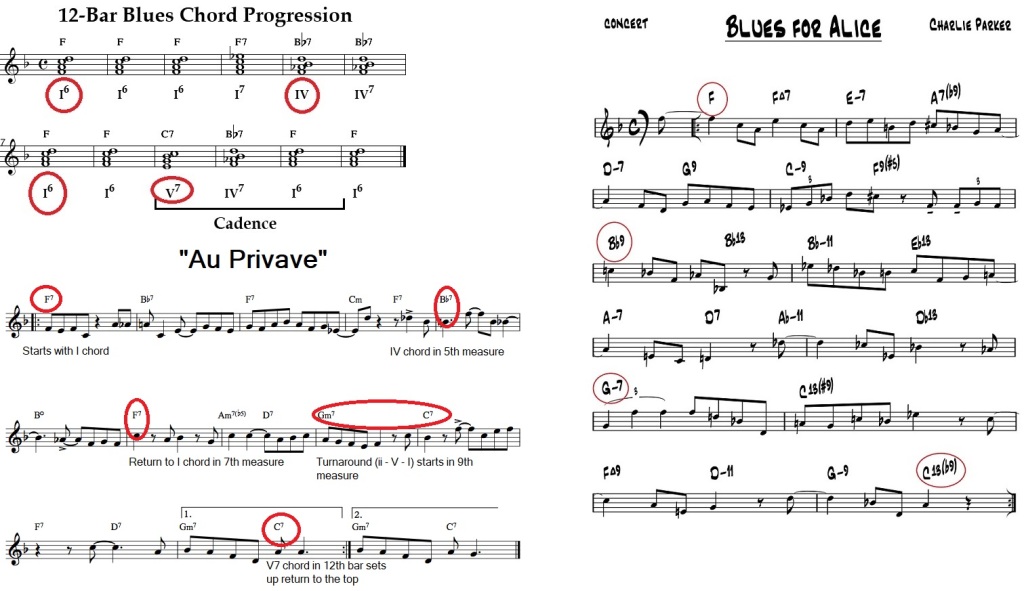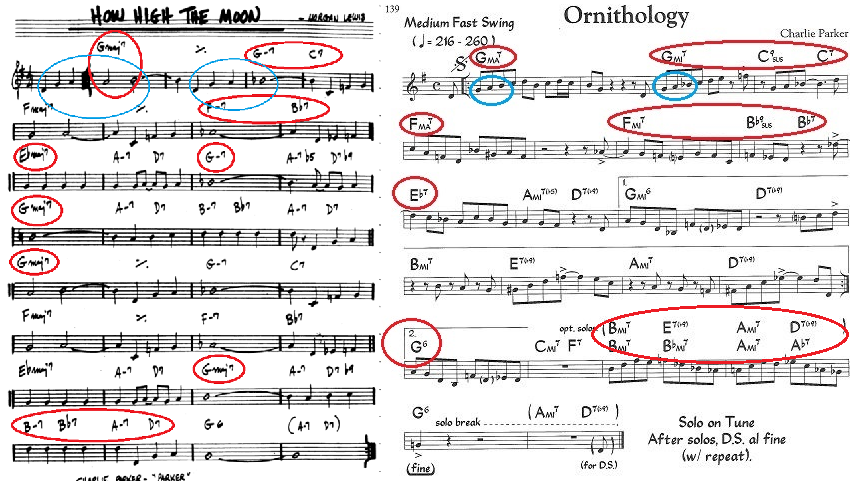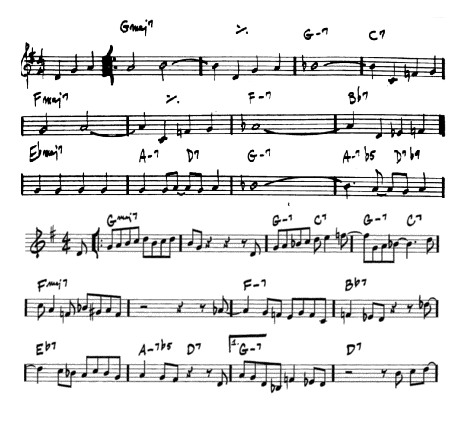In response to some questions and comments from our last post about contrafacts in music, jazz in particular, we have decided to address the subject further in this “Ask O.P.” post.
The term “contrafact” is defined by Wikipedia as “a musical work based on a prior work.” In jazz, the word is often used to describe a tune that uses an existing composition’s chord progression. A songwriter or composer can use an existing chord progression as a starting point for a new piece, while musicians learning a tune that is a contrafact can gain additional insight by comparing it to its source. Note that from a copyright standpoint, chord progressions are not considered specific enough to qualify as intellectual property, so as long as the composer creates an original melody, they are exempt from charges of plagiarism.
In this post, we will discuss two common chord progressions: the 12-bar blues and the “I Got Rhythm” changes, then explore some specific examples of contrafacts.
Blues progressions
Blues music, in particular the 12-bar progression, has served as the foundation of many songs throughout jazz, country, bluegrass, rock and other genres. Works that are based on this progression usually have three things in common: starting on the I chord (the home key), moving to the IV chord in the fifth bar and a turnaround starting in the 9th bar: a phrase that “answers” the statements if the previous two phrases and sets up a return to the top of the form.
Following are three examples of the 12-bar blues progression in the key of F. The first is a basic example. The second is Charlie Parker’s tune “Au Privave” which shares the same outline as the first example but has more active harmonic movement. The third, “Blues for Alice” is another Parker head with the same framework, but still more movement.

Comparing “Au Privave” (a typical example of “be-bop” blues) to the simpler blues progression, we see differences, but also some similarities. Both of these progressions:
- Start on the I chord (F)
- Go to the IV chord (Bb) in the 5th measure
- Return to the I chord in the 7th measure
- Start the turnaround phrase in the 9th measure
The first progression uses a V – IV – I turnaround (the 9th measure has a C7, or V7 chord; the 10th measure has Bb7, the IV chord and the 11th measure returns to the I chord) while “Au Privave” uses a ii – V7 – I turnaround (starting on the Gm7, or ii chord, then going to the C7, or V7 chord, then resolving to the F7, or I chord.)
Comparing “Au Privave” to “Blues for Alice” we again notice similarities and differences. The progression starts on the I chord as the other two do, but it quickly moves through several harmonies before resolving on the IV chord in measure 5. Instead of returning to the I chord in measure 7 as the previous progressions do, it continues to explore new harmonic terrain before arriving at the ii chord in measure 9 as “Au Privave” does. From that point on out, it follows the same progression as “Au Privave.”
As a performer, understanding how a simple blues progression can evolve into a more elaborate one such as “Blues for Alice” can help you see the progression as a whole, enabling you to not worry too much about each individual chord. As a composer, seeing how far you can go from the original blues progression and still have the basic framework intact can give you ideas about how to stretch your raw materials farther.
“I Got Rhythm”
Gershwin’s “I Got Rhythm” has a chord progression that has been used by many jazz musicians as the basis for their own compositions. The theme from “The Flintstones” is a commonly cited example of “Rhythm Changes.” Other famous be-bop standards that use Rhythm Changes include “Oleo” by Sonny Rollins and “Anthropology” by Charlie Parker. A more recent example is saxophonist Alison Young’s “One Night Stan.” The progression also made its way into rock’n’roll with the Four Seasons’ “Sherry.”
Comparing “I Got Rhythm” to “Flintstones” and “Anthropology” we see several parallels. All three follow a 32-bar “A-A-B-A” form. The “A” sections consist of a repeated two bar I-vi-ii-V7 progression (Bb6 – G7 or Gm7 – Cm7 – F7). In “I Got Rhythm” and “Anthropology” there’s the slight variation (circled in blue) of going to the Eb7 and Ab7 chords in the 6th measure. These tunes all have bridges that follow a III7-VI7-II7-V7 progression (D7 – G7 – C7 – F7) with each chord being held for two bars. Changing up the harmonic rhythm from one section to another (note how the chords in the “A” section move quickly while the chords in the “B” section last for longer) is a useful compositional tool to keep in mind should you feel stuck.

Other be-bop era examples
Several Great American Songbook era standards were used by the first generation of be-bop musicians (Charlie Parker, Dizzy Gillespie, Miles Davis et. al) as the basis for new compositions. A famous example is Parker’s tune “Ornithology”, based on “How High The Moon.” Comparing the two, we see some similarities. Both use 32-bar A-B-A-C (or A-B-A-B’) forms. Both start in the key of G, then switch from major to minor in the 3rd bar, setting up a move to F in the 5th bar. Another major to minor move in bar 7 brings us to E-flat in the 9th bar. The melody of “Ornithology” echoes “How High the Moon”’s D-G-A-B figure (circled in blue) in the first bar and the D-G-A-Bb figure in the third bar when the harmony shifts to minor.

The roots of a contrafact can be a little harder to trace when the new composition is in a different key than the original. However, by looking at relationships between the chords, we can still see parallels. An example of this is Parker’s “Donna Lee”, composed and usually played in the key of A-flat and based on “(Back Home Again in) Indiana”, usually played in the key of F. Though they look different, closer examination reveals that they follow the same blueprint. Like the pair discussed above, both are 32-bar A-B-A-C tunes. Both start with a I-VI7-II7 cadence (F – D7 – G7 or Abmaj7 – F7 – Bb7), then return to the I chord in bar 7. Both arrive at the IV chord in bar 9, use either the #iv diminished or the iv minor chord in bar 10 and return to the I chord in bar 11 before an extended turnaround sets up the next A section. At bar 23, both tunes have modulated into the relative minor (d for “Indiana” and f for “Donna Lee.”) Both tunes use a diminished chord in bar 28 as a pivot to return to the home key at the end of the form.

As a composer, comparing “Donna Lee” and “Indiana” can provide valuable insight into how one piece of music can be elaborated upon and transformed into something else. As an improvisation-oriented performer, understanding the roots of “Donna Lee” – a tune that has something of an intimidating reputation in jazz circles – can help give the musician a place to start learning it.
Composer David Lockeretz on “Jake’s Shuffle”
I had a young student named Jake who was a fan of classic rock and blues. One day I came up with a riff that I thought he’d have fun playing. The riff sounded like it belonged on the turnaround of a Delta-style blues progression, but I decided to make it the main riff of the tune rather than using it as the turnaround. When I was messing with it, I decided to stay in the I chord instead of going to the IV chord in the fifth bar, as would be typical for a blues progression. I was in the key of D, with drop-D tuning, which Jake enjoyed, and that got me thinking about “So What” and “Impressions” – the two seminal modal jazz tunes, both of which are in that key. I decided to take that modal progression – 16 bars of D, 8 bars of Eb, 8 bars of D – and play it with the blues feel. I did some things to change it up a little – I started off with a vamp, brought in an element of orchestration by having the bass double the guitar on the turnaround line and I also wrote a new melody on the bridge, whereas “So What” and “Impressions” play the melody up a half step on the bridge. Long story short: “Jake’s Shuffle” didn’t start out as a contrafact, per se, but as I was developing it I realized that it might work with the modal progression. Once I saw that, it gave the tune a ready-made outline.
Additional resources
Articled with examples and analysis here and here
Article about baritone saxophonist and prolific contrafact composer Gary Smulyan here
Partial list of notable jazz contrafacts here
One last example
“Tide” by Antonio Carlos Jobim is a Latin jazz contrafact. Listen to it and see if you can identify the original progression and its composer.

Leave a comment